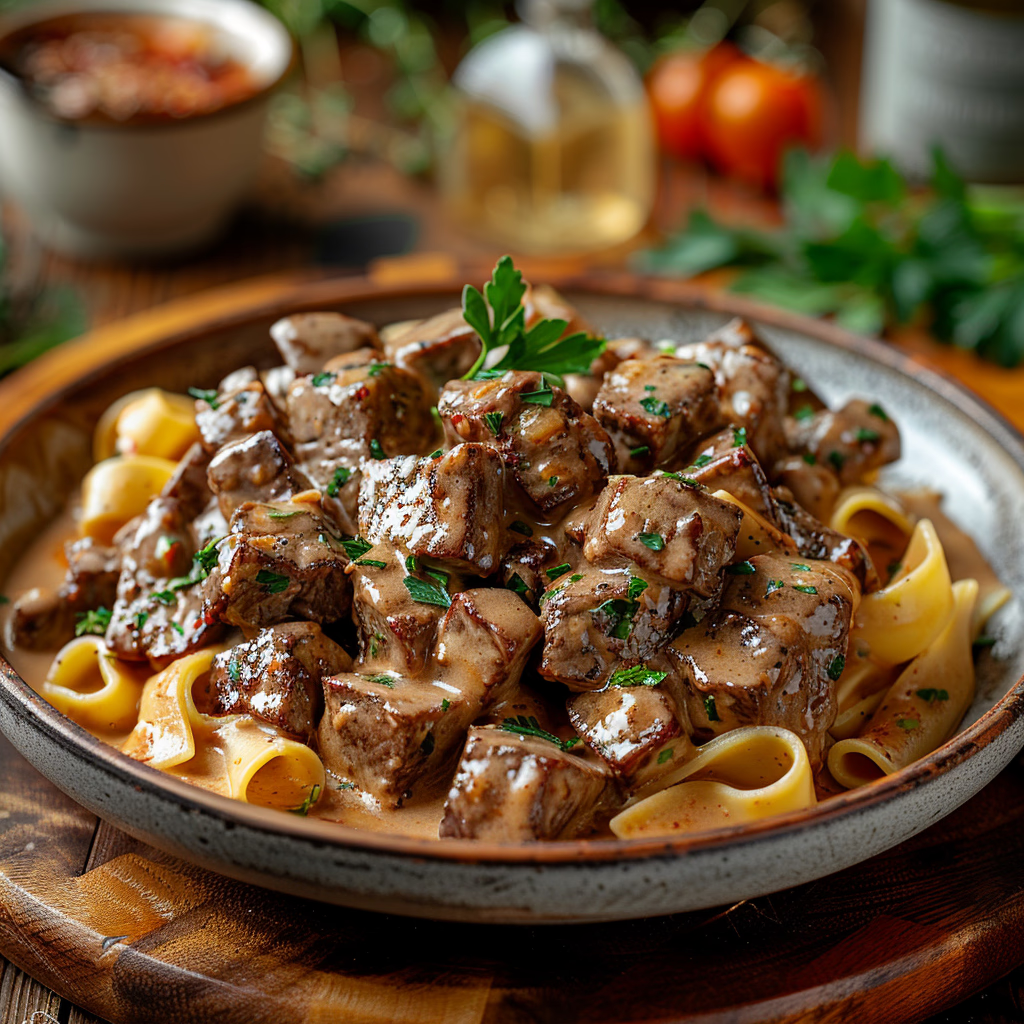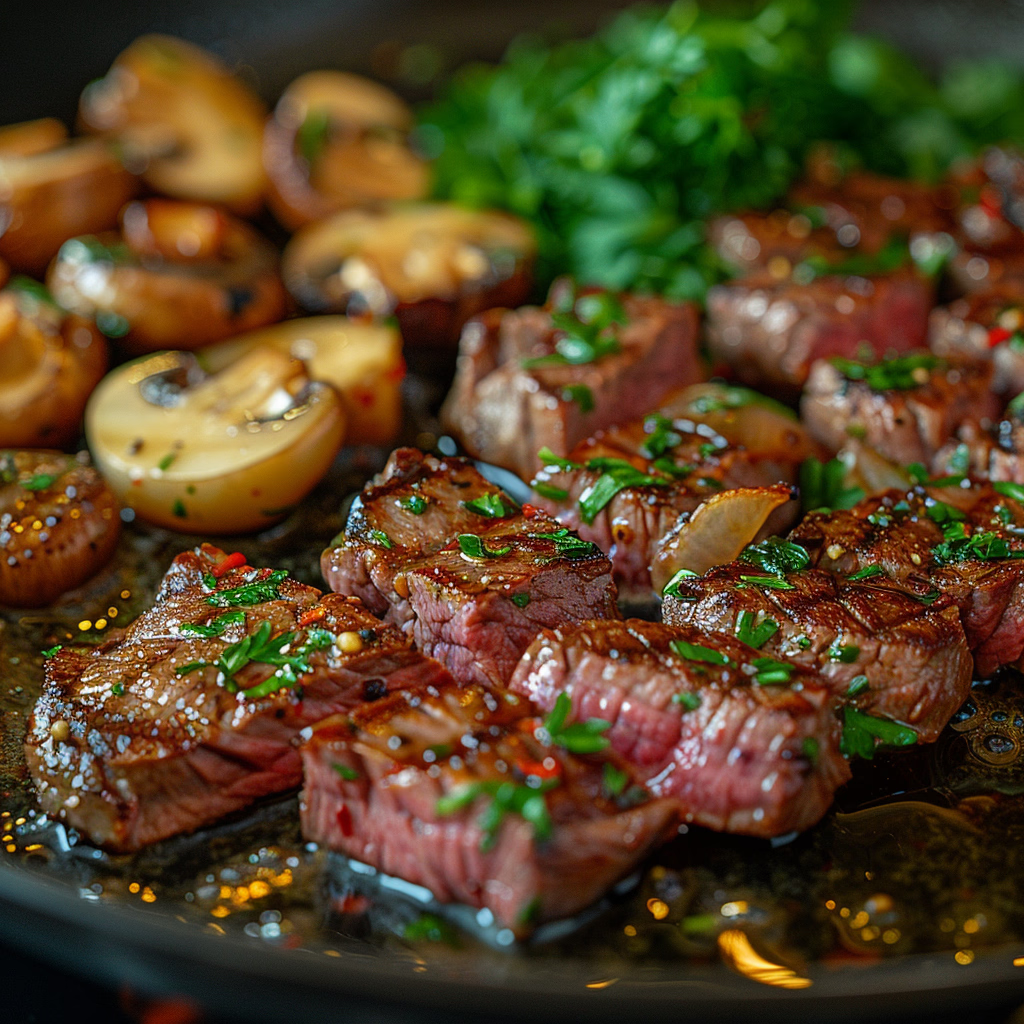Introduction:
Have you ever wondered why your stroganoff turns out gummy instead of creamy and delightful? It’s frustrating when all your hard work in the kitchen results in an undesirable texture. This article delves into the common reasons behind gummy stroganoff and provides practical solutions to fix and prevent this issue. From selecting the right ingredients to mastering the cooking techniques, you’ll discover everything you need to know to perfect your stroganoff. Let’s explore how to elevate this beloved dish to its full potential.
Part 1: Understanding the Problem
Why Is My Stroganoff Gummy?
The phrase “Why is my stroganoff gummy” often haunts home cooks when their culinary attempts fall short of expectations. Gummy stroganoff occurs primarily due to issues like overcooked beef, improper thickening techniques, or unsuitable ingredients. Each of these factors can alter the dish’s intended creamy texture into an unappetizing gummy consistency.
Common Textural Issues in Stroganoff.Gummy beef stroganoff
Stroganoff texture can range from velvety smooth to unpleasantly chewy or gluey. Many cooks encounter problems such as:
- Overly thick or pasty sauce, which clumps instead of flowing.
- Beef that’s tough, dry, or rubbery instead of tender and succulent.
- Pasta that’s either overcooked and mushy or undercooked and unappealing.
Understanding these issues is the first step toward ensuring your dish meets its full potential.
Importance of Proper Cooking Techniques:
Cooking stroganoff requires precision, as it’s a recipe with several sensitive components. Using the wrong methods can easily lead to gummy textures. For instance:
- Excessive simmering can cause proteins in the beef to overcook, making them tough.
- Adding thickening agents without careful measurement can lead to a sauce that’s gluey rather than creamy.
- Combining ingredients at incorrect temperatures may ruin the dish’s consistency.
By refining your approach, you can transform a gummy stroganoff into a masterpiece of flavor and texture.
Part 2: Identifying the Causes.Gummy beef stroganoff
Overcooking the Beef
One of the main culprits behind gummy stroganoff is overcooking the beef. When beef is exposed to excessive heat or cooked for too long, its proteins contract excessively. This process squeezes out moisture, leaving the meat tough, dry, and chewy.
Effects of Overcooking on Meat Texture
Overcooked meat becomes unappetizingly dense and rubbery. This unpleasant texture not only disrupts the enjoyment of the dish but also impacts its ability to blend well with the creamy sauce. Properly cooked beef should be tender enough to complement the sauce and pasta harmoniously.
Signs Your Beef Is Overcooked.gummy beef stroganoff
If you’re unsure whether your beef is overcooked, here are some clear signs:
- The beef feels excessively firm when bitten.
- It lacks the juicy, flavorful quality typical of well-cooked meat.
- The surface appears dry and leathery instead of slightly moist.
Avoid overcooking by using a meat thermometer to ensure you hit the ideal temperature, generally around medium-rare for most cuts.
Incorrect Beef Cuts
Using the wrong beef cut is another frequent issue. Not all cuts of beef are suitable for stroganoff, and some can lead to gummy or tough results.
Recommended Cuts for Stroganoff.gummy beef stroganoff
The best cuts for stroganoff include tender options that cook quickly and retain moisture. Examples include:
- Sirloin: A lean cut with a tender bite, perfect for quick searing.
- Ribeye: Slightly marbled, adding flavor without becoming tough.
- Tenderloin: A pricier option but guarantees a melt-in-your-mouth texture.
How to Select Quality Beef
To ensure your stroganoff is a success, always:
- Choose beef with a bright red color and fine marbling.
- Avoid cuts that appear grayish or overly fatty.
- Buy from reputable sources to ensure freshness and quality.
Inadequate Marinating
Marinating beef before cooking can significantly improve its tenderness and flavor. However, neglecting this step or marinating improperly can leave the meat tough and unpalatable.
Benefits of Marinating Beef
Marinating not only tenderizes the meat but also enhances its flavor. Ingredients like acidic components (e.g., lemon juice) or enzymes (e.g., yogurt) break down tough fibers, creating a melt-in-your-mouth texture.
Effective Marinating Techniques
Here are some tips for optimal marinating:
- Use an airtight container or resealable bag to ensure the marinade coats the beef evenly.
- Allow the meat to marinate for at least 30 minutes, but no longer than 24 hours to prevent overly soft textures.
- Avoid excessive salt in the marinade, as it can draw out moisture.
By understanding the causes of gummy stroganoff, you can make thoughtful adjustments to prevent common pitfalls. Let’s move on to the specific cooking techniques that can elevate your stroganoff from ordinary to extraordinary.
Part 3: Cooking Techniques.

Searing the Beef Properly.
Proper searing is a critical step in achieving tender, flavorful beef for stroganoff. Skipping this step or doing it incorrectly can result in a bland, rubbery texture that fails to shine in the dish.
Importance of High-Heat Searing
Searing creates a caramelized crust on the beef, locking in juices and adding depth to the flavor. Without searing, the meat can lose its moisture during cooking, leading to toughness and an unappealing texture.
Steps to Achieve a Perfect Sear
- Preheat the Pan: Heat your skillet until it’s almost smoking. This ensures the beef doesn’t stick and sears quickly.
- Use the Right Oil: Choose oils with high smoke points, like canola or avocado oil, to prevent burning.
- Pat the Beef Dry: Moisture on the surface of the meat prevents proper browning, so dry it with a paper towel.
- Avoid Overcrowding: Cook the beef in small batches to maintain high heat and ensure even browning.
- Do Not Stir Constantly: Let each side develop a crust before flipping.
By following these steps, you’ll create a flavorful base that complements the creamy sauce.
Cooking Temperature and Time.
Temperature and timing play pivotal roles in maintaining the tenderness of the beef and the consistency of the sauce. Overdoing either can lead to a gummy stroganoff.
Ideal Simmering Conditions.
Simmering gently is key. Boiling the sauce can cause proteins in the beef and dairy to coagulate, resulting in a curdled, gluey mess. Keep the heat low to medium, allowing flavors to meld without overcooking the components.
Monitoring Internal Beef Temperature.
Using a meat thermometer ensures perfect doneness. Aim for:
- Medium-Rare: 130°F to 135°F for tender beef with a slight pink center.
- Medium: 135°F to 145°F for fully cooked but still juicy beef.
Removing the beef from heat just before reaching the desired temperature allows it to finish cooking while resting.
Mistakes to Avoid During Cooking.
- Skipping Deglazing: After searing the beef, deglazing the pan with broth or wine (non-alcoholic if preferred) adds rich flavors to the sauce.
- Using High Heat for Dairy: Dairy should be added off the heat or at low temperatures to prevent curdling.
Mastering these techniques will elevate your stroganoff’s flavor and texture. Next, we’ll delve into achieving the perfect sauce consistency for a dish that’s creamy and smooth.
Part 4: Sauce Consistency
Role of Thickening Agents
The sauce is the heart of stroganoff, and its consistency can make or break the dish. Using the wrong thickening techniques can lead to a gummy, unappealing texture.
Common Thickeners Used in Stroganoff
Thickening agents vary, and each offers unique qualities. Popular choices include:
- Flour: Traditional and reliable, flour blends well but requires careful cooking to avoid a raw taste.
- Cornstarch: A gluten-free alternative that creates a glossy sauce, but overuse can lead to a gluey consistency.
- Roux: A mixture of flour and butter cooked together, offering a rich and creamy texture when added gradually.
Balancing Thickening Agents to Avoid Gumminess
Finding the right balance is essential. Here’s how to avoid over-thickening:
- Add thickening agents slowly, stirring constantly to monitor the sauce’s consistency.
- Use only the amount specified in the recipe and adjust as needed based on the desired thickness.
- Avoid letting the sauce sit too long on heat after thickening, as it may continue to thicken over time.
Incorporating Dairy Products
Sour cream is a signature ingredient in stroganoff, but mishandling it can cause curdling or contribute to a gummy texture.
Preventing Curdling of Sour Cream
Curdling occurs when dairy is exposed to high heat. To prevent this:
- Allow the sauce to cool slightly before adding the sour cream.
- Stir the cream into the sauce off the heat to maintain its creamy texture.
- Avoid prolonged simmering after adding sour cream.
Timing the Addition of Dairy for Optimal Texture
Adding dairy at the right moment ensures the sauce remains smooth. Incorporate it in the final stages of cooking, just before serving. Stir gently to create a uniform, creamy consistency that clings to the beef and pasta.
Mistakes to Avoid When Making the Sauce
- Using Cold Dairy: Bring sour cream or other dairy to room temperature before adding it to the sauce.
- Over-Thickening: Stop adding thickeners as soon as the sauce reaches the desired consistency.
By mastering sauce consistency, you’ll create a stroganoff that’s silky, rich, and flavorful. Up next, we’ll address how pasta plays a crucial role in achieving the perfect dish.
Part 5: Pasta Considerations
Selecting the Right Pasta
While stroganoff is traditionally served with egg noodles, choosing the right pasta is crucial for a harmonious dish. The wrong type or preparation can easily lead to a gummy, unappetizing mess.
Best Pasta Types for Stroganoff
The ideal pasta for stroganoff should be sturdy enough to hold up against the creamy sauce without becoming mushy. Consider these options:
- Egg Noodles: The classic choice for their slightly chewy texture and ability to soak up the sauce.
- Pappardelle: Wide, flat ribbons that offer a luxurious feel.
- Tagliatelle: Similar to pappardelle but thinner, perfect for a lighter touch.
When selecting pasta, always check for quality. Opt for varieties made with durum wheat for the best texture and flavor.
Cooking Pasta to the Correct Doneness
Overcooked pasta can contribute to a gummy stroganoff. Follow these tips to ensure the perfect texture:
- Cook the pasta al dente, meaning it should still have a slight bite.
- Use a large pot of salted boiling water to prevent clumping and ensure even cooking.
- Drain the pasta promptly and rinse briefly with cold water to stop the cooking process.
Combining Pasta with Sauce
How you mix the pasta with the sauce can also impact the dish’s texture. Poor timing or improper mixing techniques can lead to sogginess.
Timing the Mix to Maintain Texture
Combine the pasta and sauce just before serving to keep the noodles from soaking up too much liquid. This ensures a creamy consistency and prevents a gummy mess.
Ensuring Even Sauce Coating
Toss the pasta gently but thoroughly in the sauce to ensure every piece is evenly coated. Use a wide spatula or tongs to mix without breaking the noodles.
Mistakes to Avoid with Pasta
- Undercooking or Overcooking: Both mistakes can ruin the balance between pasta and sauce. Follow the package instructions closely.
- Pre-Cooking Too Early: Cook the pasta as close to serving time as possible to maintain freshness and texture.
By paying attention to pasta selection and preparation, you’ll complete your stroganoff with a base that perfectly complements the rich sauce and tender beef. Now, let’s explore some preventive measures to ensure consistent results every time.
Part 6: Preventative Measures
Proper Ingredient Preparation
Achieving a perfectly textured stroganoff starts with how you prepare your ingredients. Missteps in this early stage can lead to uneven cooking or undesirable textures in the final dish.
Slicing Beef Against the Grain
The way you slice your beef can dramatically affect its tenderness. Cutting against the grain shortens the muscle fibers, resulting in meat that’s easier to chew and less likely to turn tough during cooking. Here’s how to do it:
- Identify the direction of the muscle fibers (grain) in the beef.
- Use a sharp knife to slice perpendicular to those fibers into thin strips.
- Aim for uniform thickness to ensure even cooking.
Prepping Ingredients for Uniform Cooking
Uniformity is key when preparing vegetables like onions and mushrooms. Pieces that vary too much in size can lead to uneven cooking. Here are some tips:
- Dice onions into consistent-sized pieces to ensure they cook at the same rate.
- Slice mushrooms to a similar thickness for even sautéing.
- Measure all ingredients accurately to maintain balance in the final dish.
Utilizing Kitchen Tools
Having the right tools can save time and improve your stroganoff’s outcome. A few simple gadgets can make a world of difference.
Benefits of Meat Thermometers
A meat thermometer ensures you cook the beef to its ideal temperature, preventing overcooking or undercooking. Choose an instant-read thermometer for quick, precise results. Insert it into the thickest part of the beef to check the temperature without cutting into the meat.
Using Timers to Prevent Overcooking
Timers aren’t just for baking! Setting a timer for each stage of cooking keeps everything on track and prevents overcooking. For example:
- Use a timer for searing to avoid burning the beef.
- Set a timer when simmering the sauce to ensure it doesn’t thicken too much.
- Monitor pasta cooking time closely to achieve perfect al dente texture.
Mistakes to Avoid During Preparation
- Rushing the Prep Work: Hasty slicing or imprecise measuring can lead to uneven results. Take your time for accuracy.
- Skipping Tool Calibration: Ensure your meat thermometer and timers are functioning correctly before you start cooking.

